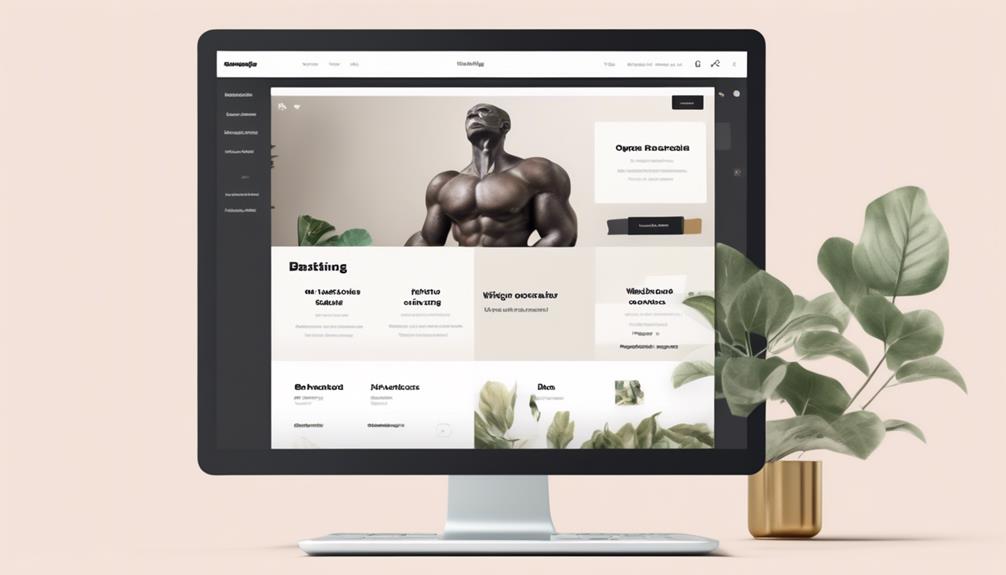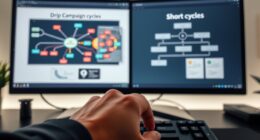Behavioral Triggers 2.0 lets you create advanced, personalized automation based on user actions. By analyzing behaviors like cart abandonment or product views, you can trigger tailored messages instantly, making your marketing highly relevant. This approach builds trust, boosts engagement, and drives conversions. Using real-time data and dynamic content, you’ll keep users connected with personalized experiences. Keep exploring to discover how to harness these triggers for smarter, more effective automation strategies.
Key Takeaways
- Leverage real-time user actions to trigger personalized automation workflows for immediate engagement.
- Utilize advanced segmentation to deliver targeted messages based on detailed behavioral data.
- Implement dynamic content that adapts instantly to user behaviors, enhancing relevance and responsiveness.
- Automate follow-ups for specific actions like cart abandonment or product views to increase conversions.
- Analyze behavior patterns continuously to refine triggers and optimize automation effectiveness.

In today’s fast-paced digital landscape, understanding behavioral triggers is more essential than ever. As a marketer or business owner, you need to anticipate your audience’s needs and respond in real-time to foster engagement and drive conversions. This is where advanced automation based on user actions comes into play, enabling you to create more personalized experiences that resonate deeply. To do this effectively, you must harness personalization tactics and data segmentation. These strategies allow you to tailor your messaging, offers, and interactions based on precise user behaviors, making your campaigns more relevant and compelling.
Personalization tactics involve customizing content and interactions to match each user’s preferences and actions. Instead of generic messages, you craft targeted communications that reflect their interests, browsing history, or purchase patterns. For example, if a user frequently shops for running shoes but hasn’t purchased yet, your automation system can trigger an email with a special discount on that product. This timely, relevant messaging increases the likelihood of conversion because it aligns with their current intent. Personalization also extends to on-site experiences, where dynamic content adjusts based on user behavior, creating a seamless and engaging journey that feels uniquely tailored to each visitor.
Effectively analyzing user behavior patterns allows you to optimize your automation workflows and ensure your messages remain timely and impactful. Combining data segmentation with personalization tactics creates a powerful automation ecosystem. You can set up triggers that respond to specific behaviors—like abandoning a shopping cart, viewing a particular product, or spending a certain amount of time on your site—and then deliver personalized content immediately. This approach not only increases engagement but also builds trust and loyalty, as users feel understood and valued. Advanced automation based on user actions turns your marketing efforts into a dynamic, responsive process, making every interaction meaningful. With these tools at your disposal, you can move beyond broad campaigns and deliver highly relevant experiences that drive results, all while maintaining efficiency through smart automation.
Frequently Asked Questions
How Can I Integrate Behavioral Triggers With Existing Marketing Tools?
You can integrate behavioral triggers with your existing marketing tools by focusing on trigger integration and ensuring tool compatibility. First, identify the platforms you use, like email or CRM systems, and check if they support trigger integration. Then, connect these tools through APIs or native integrations. This way, your automation runs seamlessly, allowing you to respond to user actions in real-time and enhance your overall marketing strategy effectively.
What Are the Best Practices for Avoiding User Frustration With Automation?
Think of user onboarding as your guiding light—keep automation helpful, not intrusive. Avoid frustration by setting clear feedback loops, so users feel heard and valued. Personalize triggers based on behavior, but don’t bombard them with messages. Test your automations regularly, and give users control over their experience. Balancing proactive engagement with respect guarantees your automation feels like a helpful hand, not a nuisance, building trust from the first interaction.
How Do I Measure the Effectiveness of Behavioral Trigger Campaigns?
You measure the effectiveness of behavioral trigger campaigns by analyzing engagement metrics like open rates, click-through rates, and conversions. Conduct A/B testing to compare different trigger messages or timing, and see which performs best. Track how users respond over time, and adjust your automation based on the data. This approach helps you optimize user interactions, ensuring your triggers drive meaningful engagement without causing frustration.
Can Behavioral Triggers Be Customized for Different User Segments?
Did you know personalized campaigns see a 20% increase in engagement? Yes, behavioral triggers can be adapted for different user segments. By applying segmentation techniques and personalization strategies, you can tailor triggers based on user behavior, preferences, and demographics. This targeted approach ensures your automation feels relevant, boosting conversions and customer satisfaction. So, leveraging segmentation techniques helps you craft more effective, personalized behavioral triggers for each user group.
What Privacy Considerations Should I Keep in Mind With Advanced Automation?
When implementing advanced automation, you need to prioritize data privacy and consent management. Make sure you clearly inform users about what data you collect and how it’s used, obtaining explicit consent. Regularly review your privacy policies, guarantee compliance with regulations like GDPR or CCPA, and give users control over their data. By doing so, you protect user trust and avoid legal issues, creating a responsible automation environment.
Conclusion
Now that you’ve glimpsed the power of Behavioral Triggers 2.0, imagine the possibilities waiting to be accessed. As you fine-tune your automation, unexpected opportunities and challenges will emerge, pushing your strategies to new heights. Are you ready to harness these advanced tools and stay ahead of the curve? The next move could redefine your approach—if you dare to explore what’s beyond the horizon. The future of user engagement is in your hands.









